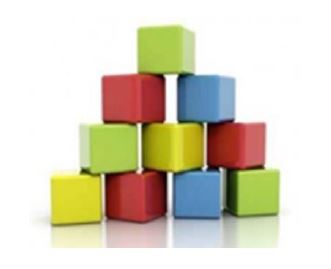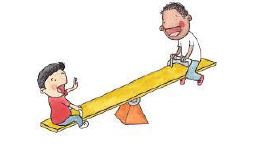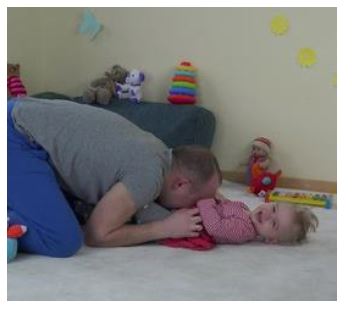

In this session we’re going to think about the importance of waiting.
When we wait, we give children the time they need to come up with an idea or to respond to what we have said or done. The way you wait is really importance too. Your facial expression will encourage your child to respond because it lets them know that you are really interested in them and you are waiting for their response.
After you have waited you may notice your child send a message back to you. This is when your respond again- and get that back and fourth communication going.
You can use ‘watch and notice’ to notice what your child does to take their turn. This will help us think about what the next stage of communication (or next rung on the ladder) will be for them. See the handout for more information on these steps.
Use the handout to help you as you try this out- pick a familiar game you play to make your child laugh. Or imitate what your child is going- then wait expectantly for them to take a turn… and then respond. You are helping to build the foundations for communication.
Introduction
 Wait
Wait
When we wait, we give children the time
they need:
– to notice what you did or said
– to come up with an idea
– to respond to what you have said or done.
Top tip – count to ten in your head before saying anything else!
It doesn’t matter whether your child finds it easy or difficult to get into a back and forth interaction – you still need to follow their lead and then wait expectantly for your child to take their turn
Wait expectantly.
When you wait, keep looking at your child. Your face should show your child that you expect him to respond.

We can see in mum’s face that she is waiting expectantly – her face is encouraging her child to respond.
At home this week, pick a routine that happens every day and try to practice waiting!
It might be at bath time, or when they are playing with their favourite game.
Or it might be when you are being quiet beside them and
imitating what they do. During that routine, when you say something to your child
(or when you take your turn by doing something), WAIT, and then look for how your child responds!
|
Dad blows raspberry on child’s tummy
|
Then Dad sits up, looks at child with an excited face and WAITS to see how child will indicate that they want more. When child indicates (no matter how) then..
|
Dad imitates what the child says, or he says what child would say if they could e.g. ‘more!”. Then Dad blows another raspberry on child’s tummy.
|
Remember that their response might not be words! Their turn might be a look, or it might just be to stop crying. When you see or hear them send a message to you, respond immediately! This will show them that you got the message and help them take another turn.

Later in this session we will think more about
what your child does to take his turn and how
those turns will develop as your child’s skill in
communicating develops – it’s a bit like climbing
up a ladder
Plan
What routine/game/action to imitate: follow your child’s lead and pick a routine that your child enjoys or a time when they are content. This might be something you often do that makes your child giggle or it might be when they lie on the floor and look at something in their hand. Make sure TV and other distractions are turned off.
Take your turn in the routine (e.g. blowing on your child’s tummy/ imitating the child’s action) and then wait. When you are waiting, keep looking at your child with an excited face.
| If your child finds it difficult to cope with eye contact then it’s ok not to look directly at them – your body language will still let them know you are waiting expectantly |

What happened when you waited?
‘Because I waited, my child ………………………………
…………………………………………………………………………………….’
(Fill in what your child did when you waited and gave him the chance to send you a message – it’s your child’s turn in the game)
When you waited you might have noticed that your child is:
– Usually upset or not interested at all
– Looking as if he is content
– Looking at me to get me to do the funny thing again
– Doing an action to get me to do the funny thing again
– Making a sound or saying a word to get me to do the funny thing again
Use this information to help you think about what the next rung of the ladder is for your child. 
| At the minute your child is doing this: | Goal is: |
| Usually upset or not interested at all | Try to find something that makes them giggle and start with that. If you can’t find something that works, then look at Session C and try quietly imitating your child |
| Looking as if he is content | To have your child look towards or at you, or make a movement to get you to do the funny thing again. You might need to exaggerate a bit and make it extra funny. |
| Looking at me to get me to do the funny thing again | To have your child wait a little longer before you do the funny thing again OR to make a movement or sound to get you to do the funny thing again – just whichever one you think is most realistic. |
| Looking at me and doing an action to get me to do the funny thing again | To keep the turns going for as long as possible OR to have your child make a sound to get you to do the funny thing again. You can help this by saying the word ‘again’ every time your child makes their movement to request you do it again. |
| Making a sound or saying a word to get me to do the funny thing again | To help the sound become a word or help the word become 2 words. If the child makes a sound then you say the word ‘again’ If the child says a word, then you add another word to it eg ‘blow again’ |
So the next step for my child is ……………………. …………………………………………………………………………………..
During this week, decide which ‘People Game’ you are going to play with your child.
– Begin the game by taking your turn
– Wait expectantly for your child to take his turn. You have written this turn, or next step, at the top of the page.
– When your child takes his turn, respond immediately by taking your turn again.
– If your child doesn’t take his next step, then you show him what to do.
– Keep repeating the game, each of you taking your turn – you may get tired of it before your child does!!!

You have helped your child get the see saw of communication going.
Session D Video: Sure Start Building Blocks for Communication – 1 (pagetiger.com)
Video Script
Wait expectantly for your child to take their turn
Welcome back! In this session we are thinking about how we need to wait and give a child time to respond to us – to get their message organised. When you wait, you give your child the time they need to come up with an idea or to respond to what you have said or done.
Waiting needs a bit of practice – we’re so used to rushing around that waiting to give a child the time they need can seem like a really long time. Some people find counting to 10 helps them practice waiting. Or when you are waiting, try to think about what your child might be thinking. That slows us down a bit and helps us to give them the time they need.
The way you wait is really important – if you wait expectantly, your face will show that you are really interested and that you are expecting your child to communicate with you. Your facial expression will really help encourage your child to respond.
Let’s watch this lovely YouTube video of a dad sneezing to make his baby laugh. While you’re watching it, notice how Dad waits expectantly for the baby to take his turn. Dad’s facial expression really gives the message –‘go on, it’s your turn’.
Did you notice Dad’s expectant waiting? He didn’t just jump straight in with another sneeze. He gave his baby time to communicate, he checked back to make sure his baby was really looking at him to get him to sneeze…. and then he responded with another sneeze. They really got a lovely seesaw of communication going where dad and baby were each taking their turn.
There were also some other lovely things to notice in the video – the baby didn’t communicate with words but there was no doubt about what message he was sending when he looked a dad and touched his face – the baby was saying ‘do that funny thing again!’ and so this tuned in Dad was able to respond by sneezing again.
It doesn’t matter if you are imitating your child’s actions, or if, like that Dad, you are doing something funny to get your child to giggle. No matter what you are doing for your turn, you then need to wait expectantly for your child to take their turn.
When you are waiting, if your child can cope with eye contact, keep looking at your child with that excited face that really invites them to take their turn. Remember to give them time to look at you, or wriggle, or move their hand before you do the funny thing again. The wait and really notice what they did to take their turn and then respond by taking your turn in the game.
If your child isn’t comfortable with a lot of eye contact then you can still wait expectantly beside them, looking towards them and wondering what they are going to do.
You can make a plan to help your child make progress in the type of turn they take. Think of it like a ladder that you are helping your child to climb. The first rung, or the first type of turn they might take may be simply staying with you and enjoying the fun. So you copy their action or sound….then wait…… and they stay around and keep playing. That’s really good because it means they are happy enough that you imitated them.
The next rung on the ladder for them might be that they stop and notice that you copied them and then they make the noise again or do the action again. Wow – that would be a fantastic way for them to take their turn. When that happens, then you take another turn and wait to see if you can keep the conversation going.
Or the next rung on the ladder for your child might be that they stop when you copy them and then look up at you for you to do it again. That’s another great way to take a turn in the conversation.
And eventually your child might take their turn by making a sound or saying a word to indicate they want you to do something again.
By following your child’s lead, you have developed a game of your own – we often call them People Games because you don’t need toys – just need people to play them. By learning to wait just that little bit longer with a lovely expectant face, you will encourage them to make progress with how they join in the conversation.

